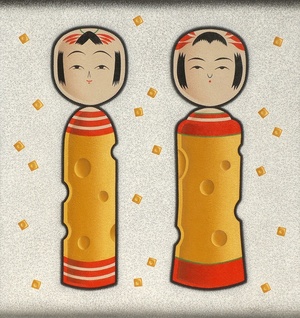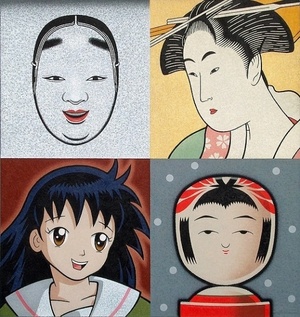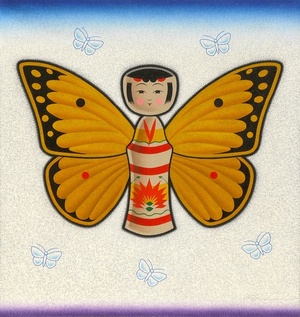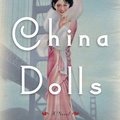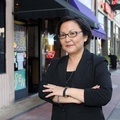Kokeshi dolls, believed to have originated in the Tohoku region of Japan, are viewed as one of the country’s most treasured folk arts. The dolls are simple in construction—wooden, cylindrical bodies with round heads—yet the Japanese American National Museum’s exhibition, Kokeshi: From Folk Art to Art Toy, showcases the true artistry and creativity embodied in these dolls. The exhibition consists of three sections that showcase the history and tradition of the kokeshi doll, as well as its influence on contemporary artists and their work. Margaret Kasahara is one of the contemporary artists whose work is exhibited, along with ten other artists, paying homage to the kokeshi dolls.
Margaret Kasahara is a Nisei, born in New York, whose parents emigrated to the United States from Tokyo, Japan. She graduated from the Kansas City Art Institute in Kansas City, Missouri, with a bachelor’s degree in Fine Arts. She began her career as a freelance commercial artist, whose client list included: American Express, Cunard Cruise Lines, Euro Disney/France, Four Seasons Hotel, Hyatt Regency/Japan, Nordstrom, and the New York Times Magazine. Since 2002, she has focused solely on her fine art work, and also began integrating kokeshi into her artwork.
In her artist’s bio, Margaret Kasahara often notes her artwork is an “exploration of identity.” She finds influence in everyday events, as well as her cultural identity as an Asian American. “Growing up in Boulder, Colorado in the 60’s and 70’s, there weren’t many Asian children during my school years—I think the overall Asian population at the time was under 1%,” recalls Kasahara. Culturally, there were not many strong Asian American role models either. “When my parents left Japan after World War II, they felt they left behind a ‘defeated’ country. Although they did not eschew Japanese culture, they held an attitude of assimilation in the U.S.,” she continues. As a result, “I grew up feeling quite disconnected with my Japanese heritage, and because I was Asian, did not feel totally embraced as a ‘real’ American by many people, nor by the cultural landscape of the time. I felt surrounded by expectations and assumptions. “It wasn’t until I left home for college that I began to look into my Japanese heritage and started to appreciate and respect my parents’ struggles as first generation immigrants.”
Over time, as the artist has come to terms with herself as a Japanese American, Margaret Kasahara’s art has conveyed more and more of the cultural influences in her life. “I didn’t start using Japanese cultural symbols and motifs in my artwork until 2002, when I was invited to participate in a ‘Color’ show,” said Kasahara. “It was at that time I realized I wanted to address my own ‘color’ and began a series of pieces based on some of the stereotypes and misunderstandings that I encountered as a child, and occasionally experience even to this day.” In her artwork, Kasahara often uses Japanese and American cultural symbols—origami cranes, sushi, and cherry blossoms (sakura), side by side with hamburgers, cowboy hats, and coca-cola bottles—to express her dual cultural identity. “I think Japanese Americans are a unique cultural blend, which bring together two disparate cultures, each one informing the other. Asian Americans continue to encounter misconceptions solely based on their appearance, which is something I’ve also addressed in my artwork,” says Kasahara.
Describing her artwork, Kasahara says, “I create still lifes using a graphic object-oriented idiom that celebrates all aspects of everyday life. The images contain bold color, high contrast, and connotative content. Simplified everyday objects figure in my pieces, many of which hold symbolic significance. I use these objects metaphorically to express a variety of relationships and interactions.” When asked about a specific inspiration for using kokeshi as a theme or motif in her artwork, she explains, “When I started creating work with the intent to express my Asian and Japanese American identity, I chose the kokeshi doll to symbolically represent Asian women, since the kokeshi are historically female,” says Kasahara. “I have also used female ukiyo-e images, noh masks and manga type images, but I particularly love the simplicity of the kokeshi doll form with their lovely painted dowel bodies and sweet faces.” When filtered through the eye of a modern artist such as Kasahara, the kokeshi are transformed into something new.
What does Kasahara hope people will take from her artwork after viewing her collection? “I like to make people smile, and I think the paintings are fun and colorful,” says Kasahara. “But, I also want viewers of the paintings to pause and think about the images and hope they take with them a little more awareness. I want to bring a voice to experiences from my past and express some of the everyday assumptions, preconceptions and misrepresentations that Asian Americans encounter,” she continues. “I approach my subject matter seriously, but, do it with a lighthearted touch. I want to bring a sense of humor to my observations, whether its questioning the name ‘Cheese Nips’ or recalling an old school yard sing/song tease about being ‘Americanese.’ I put a lot of care and thought into my work—and hope that it’s apparent.”
Margaret Kasahara’s art is featured in the Kokeshi: from Folk Art to Art Toy exhibition at the Japanese American National Museum through October 4, 2009. This winter, she will also be part of a two-person show at the Sandra Phillips Gallery in Denver, Colorado, where she will exhibit some of her newest painting and drawings.
© 2009 Japanese American National Museum



